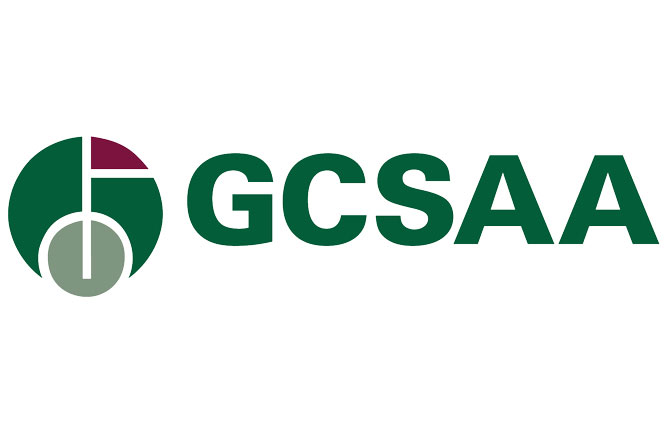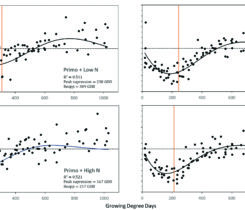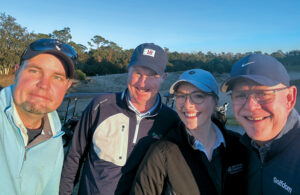Investigating irrigation requirements for cool-season fairway species
In the cool-humid and arid regions of the U.S., improved creeping bentgrass cultivars are preferred for golf course fairways due to their resilience to low mowing and rapid recovery, challenging the historical use of Kentucky bluegrass and perennial ryegrass.
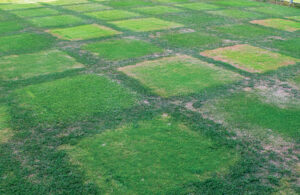
Researchers at Purdue University evaluated the irrigation requirements of six cool-season turfgrass species and ten cultivars utilizing two distinct irrigation methods: 80 percent evapotranspiration (ETo) replacement and a green cover threshold (GCT) strategy. (Photo: Jada Powlen)
New Kentucky bluegrass and turf-type tall fescue varieties now offer similar low-mowing tolerance. Yet, creeping bentgrass remains popular, with growing interest in alternatives like fine fescues and colonial bentgrass for improved playability and disease resistance (4, 8, 13, 18 and 25).
Supplemental irrigation, essential for maintaining fairway quality, especially during dry spells, has seen a push towards conservation through various strategies. However, the overall irrigated fairway area remains unchanged, underscoring the need for more efficient irrigation schedules and the adoption of drought-resistant turf varieties (16 and 17).
The method for determining turf-grass irrigation needs has advanced, incorporating techniques like digital image analysis to monitor green cover under drought conditions (20 and 29), soil moisture sensors and employing strategies based on green cover thresholds (GCT) (17) or evapotranspiration rates, potentially offering significant savings (11, 19, 23, 27, 31 and 32).
Despite these advancements, data to support the efficacy of GCT-based irrigation are still limited. Weather station calculations using methods like the Penman-Monteith equation suggest that maintaining turf quality is feasible with up to 80 percent evapotranspiration (ETo) replacement for cool-season species, indicating an opportunity for water savings without compromising turf quality (2, 6, 7, 9, 11, 14, 19, 22, 24, 26 and 33).
This evolution in irrigation strategy reflects an ongoing effort to balance the demands of golf course management with environmental sustainability, emphasizing the need for further research to optimize water use in turfgrass management (3, 5, 10, 12, 21, 28, 30 and 34).
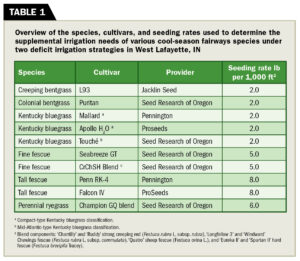 Establishment and experimental procedures
Establishment and experimental procedures
A field study conducted at the William H. Daniel Turfgrass Research and Diagnostic Center in West Lafayette, Ind., focused on evaluating the irrigation requirements of six cool-season turfgrass species and ten cultivars (Table 1) utilizing two distinct irrigation methods: 80 percent ETo replacement and a GCT strategy.
The goal was to discover more water-efficient alternatives to widely-used creeping bentgrass for cool-season fairways, leveraging digital image analysis for irrigation management and examining the GCT approach’s efficacy in preserving turf quality.
Initially, a 55 percent GCT was employed in 2017 and adjusted to 65 percent in 2018 to maintain turf quality. The GCT method demonstrates the potential for significant water savings and emphasizes the need for precise irrigation in sustainable turfgrass management.
The turf was carefully maintained at a 0.5-inch height, receiving mowing three times a week and regular applications of slow-release fertilizers and preventive fungicides to promote healthy growth and disease protection. Turf quality was evaluated bi-weekly on a 1 to 9 scale, with scores of 6 or above deemed acceptable for fairway turf.
To control moisture levels, the study utilized a fixed roof rain-out shelter, excluding natural rainfall and slightly reducing photosynthetically active radiation by about 11 percent, thus ensuring uniform experimental conditions. The shelter’s plastic cover was replaced annually, allowing soil rehydration during the off-season.
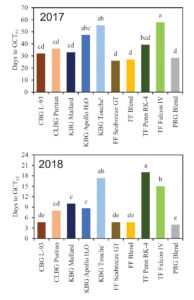
[Fig 1] Number of days after study initiation for creeping bentgrass (CBG), colonial bentgrass (CLBG), Kentucky bluegrass (KBG), fine leaf fescue (FF), tall fescue (TF), and perennial ryegrass (PRG) cultivars to reach the 55 percent green cover threshold (GCT55) in 2017 and the 65 percent green cover threshold (GCT65) in 2018. Means in the columns followed by the same letter are not significantly different according to Fisher’s protected least significant difference test (P < 0.05).
Digital imaging captured three times weekly facilitated precise green cover analysis to determine irrigation applications that effectively maintain turf health (36).
Adjustments made in 2018 to the GCT and water volumes reflect the adaptive approach to achieving optimal turf health while conserving water, showcasing the balance between environmental sustainability and maintaining fairway standards.
Irrigation applied and visual quality
Over the 60-day study periods, total ETo replacement was 10.78 inches in 2017 and 10.33 inches in 2018, with daily averages of 0.18 and 0.17 inches, respectively. In 2017, the time to reach a 55 percent GCT (GCT55) varied among species, with SeaBreeze GT fine fescue reaching it quickest and Falcon IV turf-type tall fescue taking the longest (Figure 1).
Increasing the GCT to 65 percent (GCT65) in 2018 reduced the number of days for all grasses to reach the threshold, with the perennial ryegrass blend being the fastest and the Penn RK-4 tall fescue being the slowest. The adjustment to a higher GCT in 2018 led to less time reaching the threshold across species, likely influenced by higher minimum and maximum temperatures experienced during the drought event’s initial two weeks (Figure 1).
In 2017, plots receiving 80 percent ETo irrigation received 8.63 inches of water, while those irrigated based on a GCT55 used between 0.83 and 2.90 inches, depending on the grass species or cultivar (Figure 2). Over 60 days, grasses on the 80 percent ETo schedule required 66 to 90 percent more water than those on the GCT55 strategy.
Touché Kentucky bluegrass and Falcon IV tall fescue required the lowest irrigation among GCT55 plots, demonstrating significant water savings with targeted irrigation approaches.
In 2018, the shift to a 65 percent GCT (GCT65) and an increase in supplemental irrigation to 0.33 inches per event led to higher total irrigation volumes for all turfgrass species and cultivars compared to the previous year’s GCT55 strategy, with amounts ranging from 2.97 to 7.48 inches for GCT65 treatments versus 8.26 inches for the 80 percent ETo replacement (Figure 2).
Early in the evaluation period, differences in irrigation needs were observed, with L-93 creeping bentgrass and several fine fescues requiring more water. In contrast, the two turf-type fescue cultivars and Touché Kentucky bluegrass needed the least irrigation. By employing the GCT65 approach, L-93 creeping bentgrass irrigation requirements aligned closely with the 80 percent ETo replacement strategy, with Penn RK-4 tall fescue showing the most significant water savings over the 60 days.
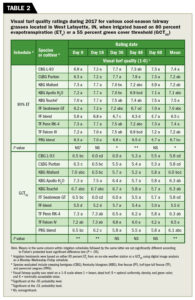 In 2017, species and cultivars receiving 80 percent ETo replacement consistently maintained acceptable turf quality (≥6.0) throughout the study, outperforming those irrigated with the GCT55 approach (Table 2). Higher turf quality was noted in Penn RK-4 tall fescue, Touché Kentucky bluegrass, L-93 creeping bentgrass, and Puritan colonial bentgrass under the 80 percent ETo regimen, especially on days 36 and 48, compared to the fine fescue and perennial ryegrass blends.
In 2017, species and cultivars receiving 80 percent ETo replacement consistently maintained acceptable turf quality (≥6.0) throughout the study, outperforming those irrigated with the GCT55 approach (Table 2). Higher turf quality was noted in Penn RK-4 tall fescue, Touché Kentucky bluegrass, L-93 creeping bentgrass, and Puritan colonial bentgrass under the 80 percent ETo regimen, especially on days 36 and 48, compared to the fine fescue and perennial ryegrass blends.
Turf-type fescue cultivars and Kentucky bluegrass varieties initially showed higher visual quality under the GCT55 irrigation. Still, by day 36, all species under this regime fell to or below a minimum acceptable quality, with tall fescue cultivars, Apollo H2O and Touché Kentucky bluegrass cultivars, eventually exhibiting slightly higher mean quality ratings.
In 2018, initial visual quality for turf receiving 80 percent ETo replacement varied, with the fine fescue blend and Puritan colonial bentgrass starting at ratings between 6.0 and 8.0, respectively, and generally consistent quality observed across Kentucky bluegrass and turf-type fescue cultivars, as well as the perennial ryegrass blend, over 60 days (Table 3).
By day 60, quality for Seabreeze GT fine fescue improved under 80 percent ETo irrigation, whereas L-93 creeping bentgrass and Puritan colonial bentgrass saw declines in quality, with the highest mean quality scores awarded to the Touché Kentucky bluegrass and turf-type fescue cultivars.
In 2018, initial turf quality for grasses under the GCT65 irrigation strategy ranged between 6.0 and 8.0. Still, values for L-93 creeping bentgrass, Puritan colonial bentgrass, Seabreeze GT fine fescue and the fine fescue blend dropped below the acceptable threshold of 6.0 by day 20. Turf-type fescue cultivars, the perennial ryegrass blend, Mallard, and Apollo H2O Kentucky bluegrass maintained consistently acceptable quality throughout the season, whereas L-93 creeping bentgrass, Puritan colonial bentgrass and fine fescues experienced quality declines after reaching the GCT65.
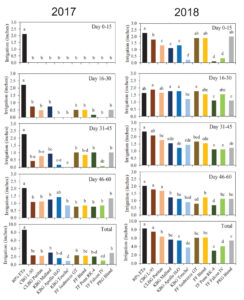
[Fig 2] Irrigation applied in 2017 using GCT55 and 2018 GCT65 threshold for creeping bentgrass (CBG), colonial bentgrass (CLBG), Kentucky bluegrass (KBG), fineleaf fescue (FF), tall fescue (TF), and perennial ryegrass (PRG) cultivars compared to 80 percent evapotranspiration (ETo) replacement during Days 0–15, 16–30, 31–45, and 46–60, and total irrigation applied during the 60-days limited irrigation event located in West Lafayette, IN. Means in the columns followed by the same letter are not significantly different according to Fisher’s protected least significant difference test (P < 0.05).
Overall impact of species selection and irrigation strategy
Supplemental irrigation is essential for maintaining the turfgrass health and playability of golf course fairways, but traditional scheduling practices that ignore actual weather conditions and evapotranspiration rates can lead to water wastage and increased costs.
In response to sustainability efforts and potential water use restrictions, many golf courses are adopting more efficient irrigation practices and considering alternative cool-season species such as fescues, which require less water than traditional choices like creeping bentgrass, thereby significantly reducing overall water consumption on fairways (35).
Previous research indicated that cool-season turf species could sustain acceptable quality with irrigation below 80 percent ETo (9 and 11). Yet, this study revealed variability among species and cultivars at 80 percent ETo replacement, with L-93 creeping bentgrass maintaining acceptable quality in 2017 but not in 2018 due to higher initial ETo rates.
The findings suggest that irrigation levels above 80 percent ETo may be necessary during periods of increased evapotranspiration to preserve turf quality. This research highlights differences in drought-resilient species, such as fine fescues and perennial ryegrass, which exhibited about 12 percent lower average quality than Touché Kentucky bluegrass and turf-type fescue cultivars under the same irrigation conditions.
A GCT irrigation approach resulted in substantial water savings — up to 77.1 percent in 2017 and 35.5 percent in 2018—compared to the traditional 80 percent ETo method across all turf species studied. Specifically, Penn RK-4 turf-type fescue utilized 64 percent less water with the GCT65 strategy while maintaining turf quality, highlighting the efficiency of Mid-Atlantic type Kentucky bluegrass cultivars, like Touché, for lower mowing heights due to its significantly reduced water needs.
Despite turf-type fescue’s advantages in water conservation and maintaining density without overseeding or significant annual bluegrass encroachment over two years in this study, concerns about its long-term performance under close mowing and disease susceptibility remain considerations for fairway use.
The study suggests utilizing a GCT of at least 65 percent to guide the irrigation needs of cool-season species on fairways, potentially leveraging future advancements in drone or camera technologies for accurate measurement.
While most species maintained acceptable quality at this threshold, a higher irrigation volume of 0.33 inches per application is recommended, noting that specific adjustments to the GCT might be necessary for species like fine fescues to account for their unique green cover characteristics.
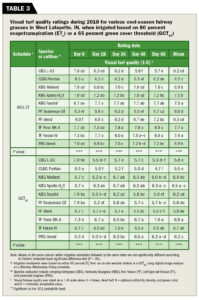 Conclusion
Conclusion
Based on this study, tall fescue and Mid-Atlantic-type Kentucky bluegrass appear to be alternatives for creeping bentgrass that could have the potential for fairway use in the cool-humid region to reduce irrigation needs.
These grasses require substantially less, 50 to 65 percent, supplemental irrigation and generally maintain higher visual quality than a traditionally maintained creeping bentgrass. Additionally, a GCT55 and GCT65 irrigation approach reduced irrigation needs by 77 and 35 percent, respectively, compared to an 80 percent ETo approach.
Further studies should evaluate wear tolerance, divot recovery, traffic tolerance, resistance to annual bluegrass encroachment and other functional characteristics before widespread adoption is fully recommended.
In summary, this field study demonstrates the ability to significantly reduce cool-season fairway supplemental irrigation by selecting species and cultivars that remain green longer under acute drought and limited irrigation.









